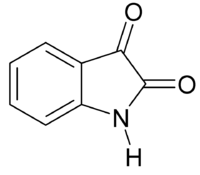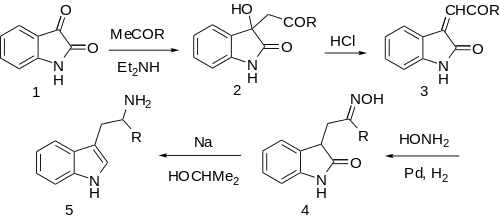Isatin
 | |
 | |
| Names | |
|---|---|
| IUPAC name
1H-indole-2,3-dione | |
| Identifiers | |
| 91-56-5 | |
| ChEBI | CHEBI:27539 |
| ChEMBL | ChEMBL326294 |
| ChemSpider | 6787 |
| DrugBank | DB02095 |
| Jmol interactive 3D | Image |
| KEGG | C11129 |
| PubChem | 7054 |
| |
| |
| Properties | |
| C8H5NO2 | |
| Molar mass | 147.1308 g/mol |
| Appearance | Orange-red solid |
| Melting point | 200 °C (392 °F; 473 K) |
| Hazards | |
| EU classification (DSD) |
Harmful (Xn) |
| R-phrases | R22 R36 R37 R38 |
| Except where otherwise noted, data are given for materials in their standard state (at 25 °C [77 °F], 100 kPa). | |
| | |
| Infobox references | |
Isatin or 1H-indole-2,3-dione is an indole derivative. The compound was first obtained by Erdmann[1] and Laurent[2] in 1841 as a product from the oxidation of indigo dye by nitric acid and chromic acids. The compound is found in many plants, such as Isatis tinctoria, Calanthe discolor and in Couroupita guianensis.[3]
Schiff bases of isatin are investigated for their pharmaceutical properties.[4]
Isatin forms a blue dye (indophenin) if it is mixed with sulfuric acid and crude benzene. The formation of the indophenin was long believed to be a reaction with benzene. Victor Meyer was able to isolate the substance responsible for this reaction from crude benzene. This new heterocyclic compound was thiophene.[5]
Synthesis
The classical methods for the synthesis of isatins are Sandmeyer’s method, the Stolle procedure, and Gassman procedure, all using aniline as substrate.[6]
Drugs
Isatin is a precursor used in the syntheses of pirquinozol, talnetant, tacrine, dibucaine, and ciclazindol, respectively.
A variety of tryptamine derivatives, including many substituted with alkyl or aryl groups in the α-position, have been prepared from isatin intermediates.
7-Trifluoromethyl-isatin is used as a precursor in the synthesis of mefloquine.
6-Chloro-isatin is for the drug Ziprasidone, respectively.
N-dichlorophenyl-isatin is for diclofenac. N-phenyl-isatin is for Linopirdine.
Reactions

Oxidation of isatin using either hydrogen peroxide or chromic anhydride yields isatoic anhydride (used for tranilast). In the oxidation of isatin to isatoic anhydride, the oxidizing agent selected should be able to introduce an oxygen atom between the two adjacent carbonyl groups without substantial decomposition of the ring system. A mixture of aqueous hydrogen peroxide in acetic or formic acid in the presence of catalytic amount of sulfuric acid is also used for the oxidation of isatin to isatoic anhydride. Another economic and environment-friendly procedure for the oxidation of isatins is through the use of the urea–hydrogen peroxide complex (percarbamide, H2NCONH2 · H2O2).
See also
References
- ↑ Erdmann, O. L. (1840). "Untersuchungen über den Indigo". Journal für Praktische Chemie 19 (1): 321–362. doi:10.1002/prac.18400190161.
- ↑ Laurent, A. (1840). "Recherches sur l'indigo". Annales de Chimie et de Physique 3 (3): 393–434.
- ↑ da Silva, J. F. M.; Garden, S. J.; Pinto, A. C. (2001). "The Chemistry of Isatins: a Review from 1975 to 1999" (pdf). Journal of the Brazilian Chemical Society 12 (3): 273–324. doi:10.1590/S0103-50532001000300002.
- ↑ Jarrahpour, A. A.; Khalili, D. (2005). "Synthesis of 3,3´-[methylenebis(3,1-phenylenenitrilo)]bis[1,3-dihydro]-2H-indol-2-one as a Novel bis-Schiff Base" (pdf). Molbank 2005 (4): M437. doi:10.3390/M437.
- ↑ Sumpter, W. C. (1944). "The Chemistry of Isatin". Chemical Reviews 34 (3): 393–434. doi:10.1021/cr60109a003.
- ↑ Hewawasam, P.; Meanwell, N. A. (1994). "A General Method for the Synthesis of Isatins". Tetrahedron Letters 35 (40): 7303–7306. doi:10.1016/0040-4039(94)85299-5.
- ↑ S. Pietra, Farmaco, Ed. Sci., 12, 946 (1957).
- ↑ S. Pietra, Farmaco, Ed. Sci., 13, 75 (1958).
- ↑ Pietra, S; Tacconi, G (1958). "Indole derivatives. III. The preparation of alpha-alkyl and of alpha-aryltryptamines". Il Farmaco; edizione scientifica 13 (12): 893–910. PMID 13619730.
- ↑ Pietra, S; Tacconi, G (1959). "Indole derivatives. Note IV. Preparation of alpha-alkyl- and alpha-aryl-N-methyltryptamines". Il Farmaco; edizione scientifica 14: 854–66. PMID 13854355.
- ↑ Pietra, S; Tacconi, G (1960). "Indole derivatives. Note 5. Synthesis of alpha-phenyl-beta-methyltryptamine". Il Farmaco; edizione scientifica 15: 451–67. PMID 13854354.
- ↑ S. Pietra, G. Tacconi, Farmaco, Ed. Sci., 16, 483 (1961).
- ↑ Deligeorgiev, Todor; Vasilev, Aleksey; Vaquero, Juan J.; Alvarez-Builla, Julio (2007). "A green synthesis of isatoic anhydrides from isatins with urea–hydrogen peroxide complex and ultrasound". Ultrasonics Sonochemistry 14 (5): 497. doi:10.1016/j.ultsonch.2006.12.003. PMID 17258493.
Reviews
- Popp, Prank D. (1975). "Advances in Heterocyclic Chemistry Volume 18". Advances in Heterocyclic Chemistry 18: 1. doi:10.1016/S0065-2725(08)60127-0. ISBN 9780120206186.
|chapter=ignored (help) - Mesropyan, E. G.; Avetisyan, A. A. (2009). "New isatin derivatives". Russian Journal of Organic Chemistry 45 (11): 1583. doi:10.1134/S1070428009110013.
